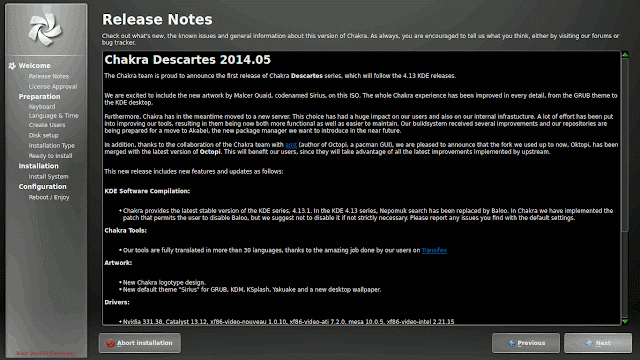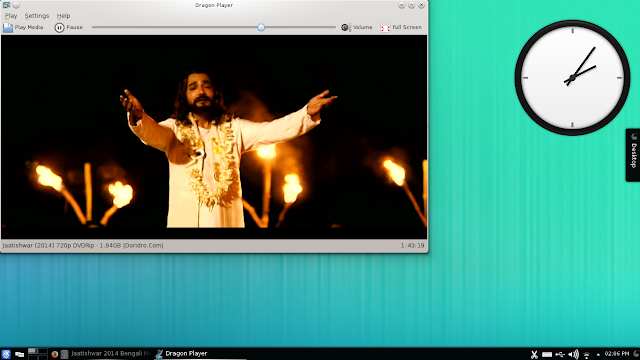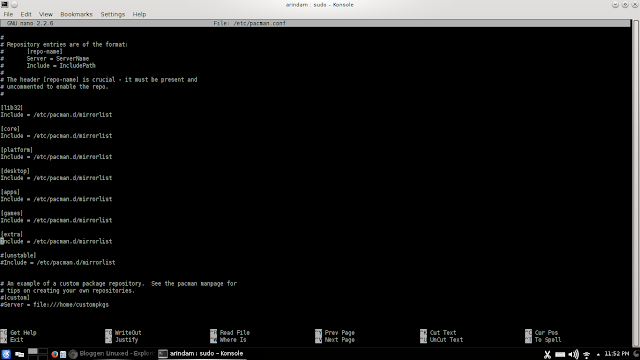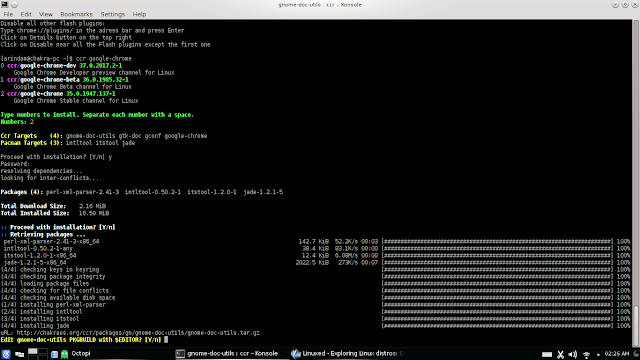Well, I tried Archlinux a couple of times and didn't get a perfect distro out of it with my limited knowledge of Linux. So, I keep on trying the next best things - Manjaro, Chakra, Antergos, and now Netrunner. My last review of Chakra was not that good - I used Arch, Manjaro and Antergos previously and thought what works with them, should work with Chakra as well. That's where I messed up big time. I forgot that Chakra split from Arch in Spring 2010 and emerged as an independent distro. And it prompted me to write another better review of Chakra after doing a fair bit of research on it.
Chakra GNU/Linux is quite unique a Linux distro intended to provide pure KDE experience to the users. It is originally based on Arch Linux and focused to provide GTK+ free KDE experience. As per Distrowatch, "Chakra GNU/Linux is a user-friendly and powerful distribution and live CD originally forked from Arch Linux. It features a graphical installer, automatic hardware detection and configuration, the latest KDE desktop, and a variety of tools and extras." It is a semi-rolling release distro, meaning the user need not to install again unless it breaks. And Chakra is very stable like Manjaro.
Chakra GNU/Linux now supports only 64-bit systems and releases one major update every quarter. The latest update is 2014.05 released in May-14. The release note mentions the following incremental improvement: "The Chakra team is proud to announce the first release of Chakra 'Descartes' series which will follow the 4.13 KDE releases. This new release includes new features and updates as follows: KDE Software Compilation - the latest stable version of the KDE series; Nepomuk search has been replaced by Baloo, we have implemented a patch that permits the user to disable Baloo; Chakra Tools are fully translated into more than 30 languages thanks to the amazing job done by our users on Transifex; artwork - new Chakra Logo and new default theme for GRUB, KDM, KSplash, Yakuake; NVIDIA 331.38 and Catalyst 13.12 drivers; Linux kernel 3.12.15, X.Org Server 1.14.5...."
I downloaded the 1.8 GB 64-bit ISO and created a live USB with Linux Mint Image Writer on a 4 GB pendrive. I installed it on my Asus K55VM laptop with 2.3 Ghz Core i7 processor, 8 GB DDR3 RAM and 2 GB NVIDIA GeForce 630M graphics, on a 50 GB partition along with Kubuntu and Linux Deepin.
Installation
Chakra GNU/Linux installation is similar to Ubuntu and one of the easiest in Linux world. Installation process is step by step and it took me around 10 minutes to install Chakra and get it running. A snapshot of the installation process is shown below.
Post Installation Script (Kapudan)
Kapudan makes Chakra more attractive to even a Linux newbie. It essentially packages a host of customization options like setting up desktop theme, decoration, wallpaper, click behavior, menu type, and a host of system configuration, post installation. For example, I changed the default KDE menu to Lancelot menu while setting up my system through Kapudan.
While it is not something too radical that an experienced user can't discover himself/herself but never the less handy. All of what Kapudan does is also readily available in KDE System Settings Manager.
Score for Installation: 10/10
Hardware Detection
Chakra GNU/Linux detected accurately screen resolution, wifi, LAN, touchpad and sound. Everything worked as expected and it works as good as any other Linux distro out there.
Score for Hardware Detection: 10/10
Aesthetics
Chakra GNU/Linux ships with it's own KDE theme which looks amazingly elegant with a light green wallpaper and black Caledonia themed panels.
In addition to the default wallpaper, Chakra has some additional good looking wallpapers pre-installed.
Special effects are, by default, subtle and don't cause distraction. I enabled the desktop cube from settings and it came out nicely.
Further, I installed conky-manager and added conkies to make it more attractive.
Grub is also installed in Chakra with it's own theme. Though the bootsplash is partly text, but it is nicely put in a box with Chakra logo and theme.
In overall, Chakra looks very elegant and is one of the few KDE distros with a signature theme. I really like it and I am going with a 10/10 for aesthetics.
Score for Aesthetics: 10/10
Pre-Installed Packages
Chakra GNU/Linux packs mostly the KDE specific applications in the distro, namely:
Adobe flash plugin is not pre-installed in the distro but the default browser, Rekonq, supports html5.
Chakra Linux ships with KDE specific packages for almost all purposes. However, I am not very comfortable with most of quite a few packages like Calligra, Rekonq, Krita, etc. and hence, had to install my favorite packages like Libreoffice, Skype 4.2, Firefox, Chromium, Google Chrome, Conky-Manager, GIMP 2.8.10, etc. to make it more usable for me.
Score for Pre-installed Packages: 8/10
Repositories and Package installation
Chakra GNU/Linux sources packages from it's own repositories. However, by default the extra repository is not enabled. I had to open terminal and run the following command:
$ sudo nano /etc/pacman.conf
to open and uncomment the extra repositories. It is required to install packages like Firefox, Chromium, VLC, etc.
Octopi is the default package browser and installer. It is labelled as "Add/Remove Software" in menu. I found it to be a bit slower than Synaptic Package Manager - it takes ages to load the repositories. Otherwise, it works pretty good and is useful to browse and install packages.
Further, Chakra has a community repo, named CCR. I enabled it to install interesting packages like Google Chrome, Google earth, conky-manager, etc. It is pretty good and easy to use.
I prefer terminal/konsole and created a guide kind of thing for installing common packages like:
****Bumblebee for Nvidia graphics****
$ sudo pacman -S nvidia-bumblebee bumblebee bbswitch
$ sudo gpasswd -a <username> bumblebee
$ sudo systemctl enable bumblebeed.service
Restart and then check if bumblebee is working by running the following command:
$ optirun glxspheres
If bumblebee is running, you'll see something like this.
One interesting observation from my side, bumblebee performs way better in Chakra than Ubuntu/Kubuntu. The frame per sec on Chakra is around 250 whereas in Ubuntu, it is around 60.
*****LibreOffice*********
$ sudo pacman -S libreoffice
It will ask in next step whether you want to install all (writer, calc, base, math, impress, etc.). Put the desired option and hit enter to install. Default option is all.
****Firefox*********
# sudo pacman -S firefox
****Chromium******
$ sudo pacman -S chromium
***Enabling community repositories****
$ sudo pacman -S ccr
****Skype 4.2*********
$ sudo pacman -S skype
****Google talk plugin *****
$ sudo pacman -S google-talkplugin
****GIMP 2.8.10*********
$ sudo pacman -S gimp
***Google-Chrome from CCR****
$ ccr google-chrome
It will throw the possible options (beta, alpha, stable, etc.). Select the desired option and hit enter. User needs to enter password wherever required. Also, it will ask if the user wants to edit the configurations of the package to be made and installed - unless there is any specific reason to edit, choose NO.
****Conky-Manager****
$ ccr conky-manager
****Google Earth****
$ ccr google-earth
Performance
During my usage, I got a very decent performance from Chakra Linux. It boots up faster than most of the KDE distros at 41 seconds. The average boot time of all KDE distros recorded on the same machine is about 52 seconds and Chakra takes about 21% less time.
Chakra takes about 560 MB RAM and 0-5% CPU at steady state with system monitor running. It is at par with the average RAM consumption of KDE distros (555 MB).
I found the desktop to be very responsive and is actually a charm to work with. Chakra definitely appears to be as one of the top KDE spins I have used this year.
Score for Performance: 8/10
Overall
Chakra GNU/Linux is definitely one of the top KDE spins available. I found it to be lightweight and offer very good performance with a faster boot up time and average resource consumption. It offered me decent battery life making it a suitable candidate for daily all purpose distro. Further, Chakra looks very elegant and offers flexibility in changing looks through Kapudan, it's post installation settings script.
Further, I found Chakra forums to be very informative. It is good that Chakra forum links are there in the welcome screen in live boot and in Kapudan. It is definitely a very helpful source of information for new users.
All-in-all, I found Chakra to be very user-friendly and suitable for both Linux novices and experts. It definitely makes Archlinux really easy with automatic hardware detection and configuration to save a lot of time. Some users may like it's GTK+ app free policy, while others may frown. I am not going into that debate but the thing is that whatever package I want to install and use, are readily available in Chakra.
Chakra gets one of the highest scores among KDE distros from my side and is definitely recommended. You can download the 64-bit ISO from here.
Overall Score: 9.2/10
Breakup
Installation (20% weight): 10/10
Hardware Detection (20% weight): 10/10
Aesthetics (20% weight): 10/10
Pre-Installed Packages (10% weight): 8/10
Performance (30% weight): 8/10
Chakra GNU/Linux is quite unique a Linux distro intended to provide pure KDE experience to the users. It is originally based on Arch Linux and focused to provide GTK+ free KDE experience. As per Distrowatch, "Chakra GNU/Linux is a user-friendly and powerful distribution and live CD originally forked from Arch Linux. It features a graphical installer, automatic hardware detection and configuration, the latest KDE desktop, and a variety of tools and extras." It is a semi-rolling release distro, meaning the user need not to install again unless it breaks. And Chakra is very stable like Manjaro.
 |
| From Chakra GNU/Linux 2014.05 http://mylinuxexplore.blogspot.in |
I downloaded the 1.8 GB 64-bit ISO and created a live USB with Linux Mint Image Writer on a 4 GB pendrive. I installed it on my Asus K55VM laptop with 2.3 Ghz Core i7 processor, 8 GB DDR3 RAM and 2 GB NVIDIA GeForce 630M graphics, on a 50 GB partition along with Kubuntu and Linux Deepin.
 |
| From Chakra GNU/Linux 2014.05 http://mylinuxexplore.blogspot.in |
Installation
Chakra GNU/Linux installation is similar to Ubuntu and one of the easiest in Linux world. Installation process is step by step and it took me around 10 minutes to install Chakra and get it running. A snapshot of the installation process is shown below.
 |
| From Chakra GNU/Linux 2014.05 http://mylinuxexplore.blogspot.in |
Kapudan makes Chakra more attractive to even a Linux newbie. It essentially packages a host of customization options like setting up desktop theme, decoration, wallpaper, click behavior, menu type, and a host of system configuration, post installation. For example, I changed the default KDE menu to Lancelot menu while setting up my system through Kapudan.
 |
| From Chakra GNU/Linux 2014.05 http://mylinuxexplore.blogspot.in |
Score for Installation: 10/10
Hardware Detection
Chakra GNU/Linux detected accurately screen resolution, wifi, LAN, touchpad and sound. Everything worked as expected and it works as good as any other Linux distro out there.
Score for Hardware Detection: 10/10
Aesthetics
Chakra GNU/Linux ships with it's own KDE theme which looks amazingly elegant with a light green wallpaper and black Caledonia themed panels.
 |
| From Chakra GNU/Linux 2014.05 http://mylinuxexplore.blogspot.in |
 |
| From Chakra GNU/Linux 2014.05 http://mylinuxexplore.blogspot.in |
 |
| From Chakra GNU/Linux 2014.05 http://mylinuxexplore.blogspot.in |
 |
| From Chakra GNU/Linux 2014.05 http://mylinuxexplore.blogspot.in |
In overall, Chakra looks very elegant and is one of the few KDE distros with a signature theme. I really like it and I am going with a 10/10 for aesthetics.
Score for Aesthetics: 10/10
Pre-Installed Packages
Chakra GNU/Linux packs mostly the KDE specific applications in the distro, namely:
- Office: Calligra Office suite 2.8.3 (Author, Flow, Sheets, Stage, Words, Kexi, Plan), Braindump, Okular document reader
- Internet: Bluedevil, KDE IM, KGet download manager, KNetAttach, Konversation, KPPP, Rekonq web browser
- Graphics: Flickrview, Gwenview image viewer, Karbon graphics, Krita, Krita Gemini & Sketch, Ksnapshot
- Multimedia: Amarok music player, AMZ downloader, Dragonplayer, FFADO Mixer, K3b CD/DVD writer, Kdenlive, Youtube viewer, QML viewer
- Accessories: Ark Archive Manager, HP Device Manager, Printer Manager, Kate notepad, Kcalc calculator, Sweeper system cleaner, KDE partition manager, Konsole, Kwallet Manager, Mini Backup, UXterm, Xterm, Yakuake terminal
- Others: Marble desktop globe, Suse Studio Image writer, Kapudan desktop greeter
 |
| From Chakra GNU/Linux 2014.05 http://mylinuxexplore.blogspot.in |
 |
| From Chakra GNU/Linux 2014.05 http://mylinuxexplore.blogspot.in |
Score for Pre-installed Packages: 8/10
Repositories and Package installation
Chakra GNU/Linux sources packages from it's own repositories. However, by default the extra repository is not enabled. I had to open terminal and run the following command:
$ sudo nano /etc/pacman.conf
to open and uncomment the extra repositories. It is required to install packages like Firefox, Chromium, VLC, etc.
 |
| From Chakra GNU/Linux 2014.05 http://mylinuxexplore.blogspot.in |
 |
| From Chakra GNU/Linux 2014.05 http://mylinuxexplore.blogspot.in |
Further, Chakra has a community repo, named CCR. I enabled it to install interesting packages like Google Chrome, Google earth, conky-manager, etc. It is pretty good and easy to use.
I prefer terminal/konsole and created a guide kind of thing for installing common packages like:
****Bumblebee for Nvidia graphics****
$ sudo pacman -S nvidia-bumblebee bumblebee bbswitch
$ sudo gpasswd -a <username> bumblebee
$ sudo systemctl enable bumblebeed.service
Restart and then check if bumblebee is working by running the following command:
$ optirun glxspheres
If bumblebee is running, you'll see something like this.
 |
| From Chakra GNU/Linux 2014.05 http://mylinuxexplore.blogspot.in |
*****LibreOffice*********
$ sudo pacman -S libreoffice
It will ask in next step whether you want to install all (writer, calc, base, math, impress, etc.). Put the desired option and hit enter to install. Default option is all.
****Firefox*********
# sudo pacman -S firefox
****Chromium******
$ sudo pacman -S chromium
***Enabling community repositories****
$ sudo pacman -S ccr
****Skype 4.2*********
$ sudo pacman -S skype
****Google talk plugin *****
$ sudo pacman -S google-talkplugin
****GIMP 2.8.10*********
$ sudo pacman -S gimp
***Google-Chrome from CCR****
$ ccr google-chrome
It will throw the possible options (beta, alpha, stable, etc.). Select the desired option and hit enter. User needs to enter password wherever required. Also, it will ask if the user wants to edit the configurations of the package to be made and installed - unless there is any specific reason to edit, choose NO.
 |
| From Chakra GNU/Linux 2014.05 http://mylinuxexplore.blogspot.in |
$ ccr conky-manager
 |
| From Chakra GNU/Linux 2014.05 http://mylinuxexplore.blogspot.in |
$ ccr google-earth
Performance
During my usage, I got a very decent performance from Chakra Linux. It boots up faster than most of the KDE distros at 41 seconds. The average boot time of all KDE distros recorded on the same machine is about 52 seconds and Chakra takes about 21% less time.
Chakra takes about 560 MB RAM and 0-5% CPU at steady state with system monitor running. It is at par with the average RAM consumption of KDE distros (555 MB).
| Operating System (64 bit) | Size of ISO (GB) | Base | Desktop | Linux kernel | CPU (%) | RAM usage (MB) | Size of installation |
| Debian KDE 7.3.0 | 0.7 | Debian Wheezy | KDE 4.8.4 | 3.2.0 | 0-5% | 423 | 4.1 |
| Neptune 3.3 | 1.9 | Debian Wheezy | KDE 4.11.2 | 3.10.12 | 0-5% | 439 | 7.2 |
| Netrunner 13.06 | 1.4 | Ubuntu Raring | KDE 4.10.5 | 3.8.0 | 0-5% | 475 | 5.9 |
| Siduction 13.2.0 | 1.2 | Debian Unstable | KDE 4.11.4 | 3.12.0 | 0-5% | 478 | 3.7 |
| Mint 15 KDE | 1.4 | Ubuntu Raring | KDE 4.10.5 | 3.8.0 | 0-5% | 483 | 7.0 |
| Solydk 2013.11 | 1.6 | Debian Testing | KDE 4.11.3 | 3.10.3 | 0-5% | 484 | 6.2 |
| Bridge Linux 2013.06 | 1.0 | Arch | KDE 4.10.4 | 3.12.5 | 0-5% | 490 | 4.6 |
| Mint 16 KDE | 1.4 | Ubuntu Saucy | KDE 4.11.3 | 3.11.0 | 0-5% | 496 | 7.0 |
| PCLinuxOS 2013.12 | 1.6 | Mandriva | KDE 4.11.3 | 3.4.70 | 0-10% | 496 | 5.8 |
| Kwheezy 1.4 | 4.0 | Debian Wheezy | KDE 4.8.4 | 3.2.0 | 0-10% | 511 | 12.4 |
| Kubuntu 13.04 | 0.9 | Ubuntu Raring | KDE 4.10.5 | 3.8.0 | 0-10% | 523 | 4.9 |
| Manjaro Linux 0.8.9 KDE | 1.8 | Arch | KDE 4.12.2 | 3.10.30 | 0-5% | 528 | 4.9 |
| Mageia 3 | 1.4 | Mandriva | KDE 4.10.2 | 3.8.0 | 0-5% | 530 | 3.9 |
| Calculate Linux 13.11 KDE | 2.3 | Gentoo | KDE 4.11.3 | 3.10.19 | 0-5% | 537 | 7.1 |
| Mageia 4 | 3.6 | Mandriva | KDE 4.11.4 | 3.12.8 | 0-5% | 540 | 8 |
| Kubuntu 13.10 | 1.0 | Ubuntu Saucy | KDE 4.11.2 | 3.11.0 | 0-5% | 547 | 5.2 |
| Chakra Fritz 2013.09 | 1.8 | Arch | KDE 4.11.1 | 3.10.10 | 0-10% | 550 | 5.0 |
| Chakra GNU/Linux 2014.05 | 1.8 | Arch | KDE 4.13.1 | 3.12.15 | 0-5% | 560 | 4.8 |
| Kubuntu 14.04 LTS | 1.0 | Ubuntu Trusty | KDE 4.13.0 | 3.13.0 | 0-5% | 590 | 4.6 |
| OpenSUSE 13.1 | 4.4 | OpenSUSE | KDE 4.11.2 | 3.11.6 | 0-5% | 593 | 6.0 |
| Chakra 2014.02 | 1.7 | Mandriva | KDE 4.12.2 | 3.12.6 | 0-5% | 618 | 4.1 |
| ROSA Fresh KDE R2 | 1.6 | Mandriva | KDE 4.11.3 | 3.10.19 | 0-5% | 620 | 5.4 |
| Netrunner 13.12 | 1.6 | Ubuntu Saucy | KDE 4.11.2 | 3.11.0 | 0-10% | 623 | 7.2 |
| Manjaro Linux 0.8.8 KDE | 2.0 | Arch | KDE 4.11.3 | 3.10.24 | 0-10% | 655 | 5.0 |
| Fedora 20 KDE | 0.9 | Fedora | KDE 4.11.3 | 3.12.5 | 0-5% | 691 | 8.4 |
| Korora 19.1 | 2.4 | Fedora | KDE 4.11.1 | 3.11.2 | 0-5% | 697 | 9.2 |
| OpenSUSE 13.1.1 Education Li-f-e | 3.3 | OpenSUSE | KDE 4.12.1 | 3.11.6 | 0-5% | 730 | 9.3 |
| Korora 20 | 2.3 | Fedora | KDE 4.11.5 | 3.12.6 | 0-5% | 750 | 8.0 |
Score for Performance: 8/10
Overall
Chakra GNU/Linux is definitely one of the top KDE spins available. I found it to be lightweight and offer very good performance with a faster boot up time and average resource consumption. It offered me decent battery life making it a suitable candidate for daily all purpose distro. Further, Chakra looks very elegant and offers flexibility in changing looks through Kapudan, it's post installation settings script.
Further, I found Chakra forums to be very informative. It is good that Chakra forum links are there in the welcome screen in live boot and in Kapudan. It is definitely a very helpful source of information for new users.
All-in-all, I found Chakra to be very user-friendly and suitable for both Linux novices and experts. It definitely makes Archlinux really easy with automatic hardware detection and configuration to save a lot of time. Some users may like it's GTK+ app free policy, while others may frown. I am not going into that debate but the thing is that whatever package I want to install and use, are readily available in Chakra.
Chakra gets one of the highest scores among KDE distros from my side and is definitely recommended. You can download the 64-bit ISO from here.
Overall Score: 9.2/10
Breakup
Installation (20% weight): 10/10
Hardware Detection (20% weight): 10/10
Aesthetics (20% weight): 10/10
Pre-Installed Packages (10% weight): 8/10
Performance (30% weight): 8/10
Great review, as usual.
ReplyDeleteGiven the rolling nature of the distro it is prudent to get in a habit of updating before installing new packages. For example:
'sudo pacman -Syyu skype' rather than
'sudo pacman -S skype'.
I presume you were working with a fresh image and updated first before installing anything, but just wanted to highlight this as some users might run into trouble if they haven't updated in a while and then install a package with only -S option.
Thanks for posting this. I have been dabbling in Arch based distros lately and this helps out a lot!
DeleteThanks for posting this. Mine was a fresh install and pacman -S worked pretty good. For ongoing basis, your suggestion definitely helps!
Deleteis it true though that KDE distros are slow in the launching of Apps and responding to most clicks
ReplyDeleteKDE4 distros take a bit of more time to boot but are at par with other DEs in terms of responsiveness. I hope it helps.
DeletePlease Arindam review this distro:
ReplyDeletehttp://distrowatch.com/table.php?distribution=lite
It seems like has evolutionated
Using Lite currently and you are right, it has evolutioned! Will post a review by Saturday.
DeleteAnother nice review Arindam!
ReplyDeleteOctopi is slow because it hasnt been stable for a long time yet so I guess if we give it some time it will mature and become more performant that it is now.
I think this is the first version of Chakra that, besides of the mentioned state of octopi, feels really polished and almost flawless. When i previously tried Chakra I always ran into little showstoppers here and there. Plus I somewhat dislike their diehard KDE focus(but this is based on my dislike on KDE), although I have to admit, that imho Chakra has one of the nices KDE implementations out there not least because of the great tool kapudan which sadly is still ignored by other distributions.
We live in great/horrible times considering the available choice of excellent distributions. I still keep hopping between distributions every now and then ^^
Thanks for you comments. I agree with you that this is the most refined Chakra I've ever used. Like you, even I'm going through great/horrible times, spoilt by abundance of Linux distros and not sure when my hopping will stop :).
DeleteA very good and satisfying review. I have always wanted to use Chakra but didn't dare to because of very limited knowledge of Arch linux as well as Chakra so I have to stuck to Linux mint or any popular debian based distro but today i am much confident and will surely try it very soon. All thanks to you.
ReplyDelete